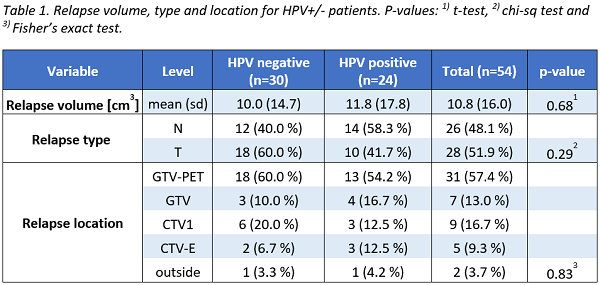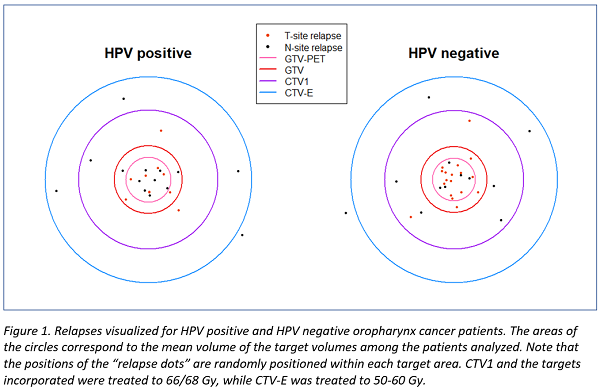Relapse pattern in relation to FDG-PET and target volumes in HPV positive/negative oropharynx cancer
Katrin Håkansson,
Denmark
PO-1084
Abstract
Relapse pattern in relation to FDG-PET and target volumes in HPV positive/negative oropharynx cancer
Authors: Katrin Håkansson1, Anne Marie Lindegaard1, Mogens Bernsdorf1, Anita Gothelf1, Claus Andrup Kristensen1, Lena Specht1, Jeppe Friborg1, Ivan Richter Vogelius1
1Rigshospitalet Copenhagen University Hospital, Department of Oncology, Copenhagen, Denmark
Show Affiliations
Hide Affiliations
Purpose or Objective
It is known
that patients with HPV positive squamous cell carcinoma of the oropharynx (OPSCC)
have a lower absolute risk of locoregional relapse (LRR) and a relatively
higher rate of distant metastasis than HPV negative OPSCC patients. Therefore,
it is not unlikely that the relapse pattern within different parts of the tumor/elective
volumes also differs for this patient group. This could potentially influence
how the distribution of radiation dose should ideally be optimized. The aim of
the current work was to compare the relapse pattern in HPV negative and
positive OPSCC patients, in relation to FDG-PET avid volumes and RT target
structures at baseline. In
addition, we wanted to see if the findings of a previous study in a mixed HNSCC
population1 – that most relapses originate within the FDG-PET avid
volume – was valid also in the current population of OPSCC patients only.
Material and Methods
Among 632
OPSCC patients treated 2009-2017, 40 patients with known HPV status and
isolated LRR were included. Patients where journal charts indicated persistent
disease after RT were excluded (independent chart review is ongoing).
Oncologists contoured relapse volumes (RV) on relapse scans (CT, PET/CT or
MR). The relapse scans
and RV structures were deformably registered to the planning CT, and the point
of origin (POI) was estimated using a nidus/centre of volume strategy1.
The relapse (POI) positions were analyzed in relation to the following
volumes/targets: FDG-PET avid volume (GTV-PET), gross tumor volume (GTV) and high-dose
clinical target volume (CTV1), all 66-68 Gy. Elective volume (CTV-E), 50-60 Gy.
The relapse pattern was compared between HPV negative and positive patients
with appropriate statistics (for details, see Table 1 caption).
Results
Fifty-four RV:s
were found in the 40 patients. Of these, 31 originated from GTV-PET, while the
other RT targets (excluding any targets incorporated) harbored 7 (GTV), 9
(CTV1) and 5 (CTV-E) relapses. Two nodal relapses were found outside the RT
target volumes (Table 1). No significant difference in relapse volume was found
between HPV negative and positive patients (Table 1). The distribution of POI
positions among HPV negative and positive patients are visualized in Figure 1.
No significant difference in relapse pattern in relation to the target volumes was found (Fisher’s exact test, p=0.83).
Conclusion
The data do
not suggest any difference in relapse pattern in relation to FDG-PET and RT
target volumes between HPV negative and positive OPSCC patients. In agreement
with previous findings, the majority of relapses were found in GTV-PET.
1 Due
et al. “Recurrences after intensity
modulated radiotherapy for head and neck squamous cell carcinoma more likely to
originate from regions with high baseline [18F]-FDG uptake”. Radiother Oncol
2014;111:360-5

